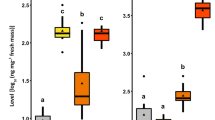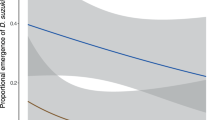Abstract
LARVAE of the seedcorn maggot, Hylemya platura (Meigen) may damage or kill young plants of many crop species by feeding on the cotyledons and plumules (Fig. 1). Damage may be caused by larvae already present in the soil before the seeds are planted1 or by larvae that hatch from eggs laid near germinating seeds2,3. It has been assumed that the stimulus for oviposition is provided by the germinating seeds themselves but we suspected that seed-borne microoiganisms growing on seed exudates could produce metabolites that promote oviposition. Many metabolic processes begin at the onset of seed germination, and concurrently organic substances are leached from the seeds which provide substrates for microorganisms. We now report that microorganisms growing on substrates from seeds produce metabolites which simulate egg laying in H. platura, and that germinating microorganism-free seeds are not stimulatory. This is an excellent example of a complex ecological interaction between an insect pest, the host plant and organisms of the microenvironment.
This is a preview of subscription content, access via your institution
Access options
Subscribe to this journal
Receive 51 print issues and online access
$199.00 per year
only $3.90 per issue
Buy this article
- Purchase on Springer Link
- Instant access to full article PDF
Prices may be subject to local taxes which are calculated during checkout
Similar content being viewed by others
References
Miller, L. A., and McClanahan, R. J., Can. Ent. 92, 210–221 (1960).
Barlow, C. A., Ent. exp. appl., 8, 83–95 (1965).
Yu, C. C., Webb, D. R., Kuhr, R. J., and Eckenrode, C. J., Environ. Ent. (in the press).
Harris, C. R., Svec, H. J., and Begg, J. A., J. econ. Ent., 59, 407–410 (1966).
Horsfall, W. R., Mosquito News, 16, 66–71 (1956).
Harman, G. E., and Pfleger, F. L., Phytopathology, 64, 1339–1344 (1974).
Buchanan, R. E., and Gibbons, N. E., Bergy's Manual of Determinative Bacteriology, ninth ed. (Williams and Wilkins, Baltimore, 1974).
Lodder, J., and Kreger-Van Rij, N. J. W., The Yeasts—A Taxonomic Study (Interscience, New York, 1952).
Tette, J. P., in Pheromones (edit. by Birch, M. C.), 399–410 (American Elsevier, New York, 1974).
Author information
Authors and Affiliations
Rights and permissions
About this article
Cite this article
ECKENRODE, C., HARMAN, G. & WEBB, D. Seed-borne microorganisms stimulate seedcorn maggot egg laying. Nature 256, 487–488 (1975). https://doi.org/10.1038/256487a0
Received:
Accepted:
Published:
Issue Date:
DOI: https://doi.org/10.1038/256487a0
This article is cited by
-
10.1007/BF00367166
CrossRef Listing of Deleted DOIs (2011)
-
Oviposition in Delia platura (Diptera, Anthomyiidae): The Role of Volatile and Contact Cues of Bean
Journal of Chemical Ecology (2006)
-
Oviposition behaviour of two tephritid fruit flies, Dacus tryoni and Dacus jarvisi, as influenced by the presence of larvae in the host fruit
Oecologia (1984)
Comments
By submitting a comment you agree to abide by our Terms and Community Guidelines. If you find something abusive or that does not comply with our terms or guidelines please flag it as inappropriate.



